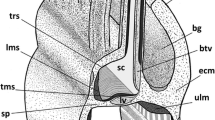Abstract
We have examined with transmission electron microscopythe epithelial layer exposed to the rhynchocoel fluidof the proboscis in the heteronemertine Riseriellus occultus. This epithelium is organized asa monociliated, pseudostratified myoepitheliumconsisting of two cell types: apically situatedmonociliated supportive cells and subapical myocyteslacking cilia. The low supportive cells form acontinuous adluminal sheet and reach with numerouscytoplasmic processes into the extracellular matrix;these cells are characterized by numerous, irregularlyshaped, apical folds projecting into the rhynchocoelfluid, delimiting broad extracellular spaces. Theauthors suppose that both apical and basal folds couldaccommodate stretching of the endothelium when theproboscis is everted. The apical folds of thesupportive cells increase the interface of these withthe rhynchocoel fluid; this feature, together with thepresence of pinocytotic vesicles in such cells,suggest that they could be involved in the exchange ofsubstances between the rhynchocoel fluid and theproboscis. The myocytes are scattered singly withinthe monociliated pseudostratified myoepithelium. Theyare situated between the supportive cells and thesubjacent extracellular matrix. Basement membraneseparating both cells types is lacking. Myofibrillarparts protrude basally from the myocyte somata. Themyofibrillar parts lie in direct apposition to theextracellular matrix, and are oriented circular to thelongitudinal axis of the proboscis. We consider themyocytes to be intra-epithelial, myoepithelial cells.
Similar content being viewed by others
References
Anadón, N., 1976. Aportaciones a la estructura y ultraestructura de los heteronemertinos (Segunda parte). Bol. r. Soc. esp. Hist. nat. Secc. Biol. 74: 83–114.
Bürger, O., 1895. Die Nemertinen des Golfes von Neapel und der angrenzenden Meeres-Abschnitte. Fauna Flora Golf. Neapel 22: 1–743.
Gibson, R., 1972. Nemerteans. Hutchinson, London, 224 pp.
Gibson, R., 1985. The need for a standard approach to taxonomic descriptions of nemerteans. Am. Zool. 25: 5–14.
Gibson, R. & E. Egan, 1976. Some histochemical observations on digestive and other enzymes of the entozoic hoplonemertean Gononemertes australensis Gibson, with comments on its possible feeding behaviour. J. exp. mar. Biol. Ecol. 24: 285–296.
Jennings, J. B. & R. Gibson, 1969. Observations on the nutrition of seven species of rhynchocoelan worms. Biol. Bull. 136: 405–433.
Ling, E. A., 1971. The proboscis apparatus of the nemertine Lineus ruber. Philos. Trans. r. Soc., Lond. Biol. 262: 1–22.
Montalvo, S., J. Junoy, C. Roldán & P. García-Corrales, 1996. Ultrastructural study of sensory cells of the proboscidial glandular epithelium of Riseriellus occultus (Nemertea, Heteronemertea). J. Morph. 229: 83–96.
Norenburg, J., 1986. Redescription of a brooding nemertine, Cyanophthalma obscura (Schultze) gen. et com. n., with observations on its biology and discussion of the species of Prostomatellaand related taxa. Zool. Scr. 15: 275–293.
Norenburg, J., 1993. Riserius pugetensis gen. n., sp. n. (Nemertina: Anopla), a new mesopsammic species, and comments on phylogenetics of some anoplan characters. Hydrobiologia 266: 203–205.
Rieger, R. M. & J. Lombardi, 1987. Ultrastructure of coelomic lining in echinoderm podia significance for concepts in the evolution of muscle and peritoneal cells. Zoomorphology 107: 191–208.
Rogers A. D., J. Junoy, R. Gibson & J. P. Thorpe, 1993. Enzyme electrophoresis, genetic identity and description of a new genus and species of heteronemertean (Nemertea, Anopla) from northwestern Spain and North Wales. Hydrobiologia 266: 219–238.
Sánchez, M. & H. J. Moreto. 1984. Redescription of the heteronemertean Lineus atrocaeruleus (Schmarda, 1859). Zool. Scr. 13: 133–188.
Stricker, S. A., 1985. The stylet apparatus of monostiliferous hoplonemerteans. Am. Zool. 25: 87–97.
Stricker, S. A. & R. A. Cloney, 1981. The stylet apparatus of the nemertean Paranemertes peregrina: its ultrastructure and role in prey capture. Zoomorphology 97: 205–223.
Stricker, S. A. & R. A. Cloney, 1983. The ultrastructure of venom-producing cells in Paranemertes peregrina (Nemertea, Hoplonemertea). J. Morph. 177: 89–107.
Thompson, C. B., 1901. Zygeupolia litoralis, a new heteronemertean. Proc. Acad. nat. Sci. Phila. 53: 657–739.
Turbeville, J. M., 1991. Nemertina. In F. W. Harrison & E. Ruppert (eds). Microscopic Anatomy of Invertebrates 3, Platyhelminthes and Nemertina. Wiley-Liss, New York: 285–328.
Turbeville, J. M. & E. E. Ruppert, 1985. Comparative ultrastructure and the evolution of nemertines. Am. Zool. 25: 53–71.
Author information
Authors and Affiliations
Rights and permissions
About this article
Cite this article
Montalvo, S., Junoy, J., Roldán, C. et al. Ultrastructural study of the proboscis endothelium of Riseriellus occultus (Nemertea, Heteronemertea). Hydrobiologia 365, 121–127 (1997). https://doi.org/10.1023/A:1003101703985
Issue Date:
DOI: https://doi.org/10.1023/A:1003101703985




